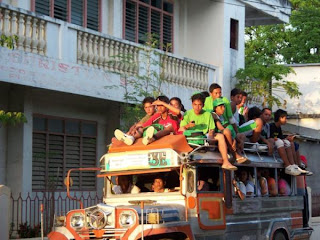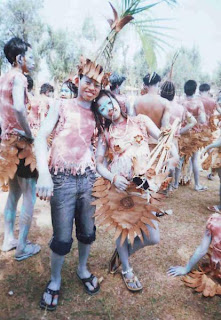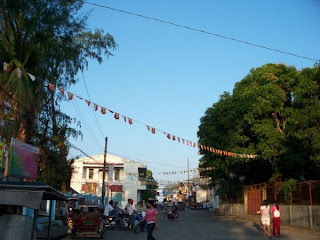HISTORICAL BACKGROUND
The aborigines of this town were the Negritos. It is believed that those people came from a tribe in Iloilo under Chieftain Juan Marikudo. For their route they used the island of Carabao Island between Tablas and Panay as “bridge”. These tribes increased after the followers of Marikudo who were displaced by the Bornean Datus migrated to Tablas during the 14th century. At Tablas coeast they for sometime but later on, more advanced groups of settlers pushed from firther to inner Tablas in what is now Pato-o and Langit-non. At present, traces of Negritos blood can be seen among the “Kalibogans”, Negrito half-breeds of Pato-o Langitnon.
The Mangyans were the next settlers who came to Odiongan from Mindoro. When and how they came to Odiongan is not definitely known. The Mangyans came however, in a very tible in the area.
The next group of settlers who came to Odiongan were the Onhans and the Nayons from Panay. They were the more civilized group of settlres, with more advanced tools in production, culture, and warfare. They drove group the Negritos and Mangyans firther to the interior mountains and occupied the coastal regions. But because they came in small nuber, their tribe was displaced by succceding tribes. Their traces can be found today in the Ferrol town, Atabay and Ginagoman. These are the places now in Odiongan whose residents speak in Inonhan”.

Sometimes in 1810, an attempt was made by the Bantoanons to setle in Odiongan.
They numbered around fifty determined men and women under the leadership of a certain Jose Barrion. They organized a settlement in a well-chosen place, suited for agriculture. They were highly civilized, industrious, and determined people imbued with the spirit of oneness and civic consciousness. They built housed of light materials and the community must have been on the way to progress when its settlement was destroyed and burned by pillaging Moros.
In 1840, another settlement from the same people, a now under the leadership of Franscisco Salazar and Fray Jose Aznar de los Dolores, attempted in the same area. These people came equally determined. They were deeply religious, civic-spirited,, disciplined and helpful group. They found a well located site, free from immediate dangers of outside depredations. The site—the “cota”(fort)- has a natural defense against marauding Motors, This was the settlement that withstood the depredations and the hardships of pioneering life.
The name Odiongan was derived from “Odiong”, a local term for arrow. The story goest that sometime during the height of Moro forays against Christians in the Visayas and Mindanao (Which was a reaction to the war of annihilation waged by the Spanish colonialists against Muslim of South), a Moro contingent attacked the “Coto”, a fort situated in a midget peninsula between the Bongoy and Bangon Rivers. The people of Odiongan under the leadership of Fransisco Salazar resisted. After the particular battle, an arrow, so the story goes. The place-swampy land now sandwich between the Fermalo and Washington Bridges— usuage. Odiongan emerged as the popular name.
The Cota was frequently subjected to attacks by Moros that the settlers from superior forces. In 1884, a strong typhoon belevelled the settlement to the grounds. This Catastrophe and the burning of the village two years later in December, 1846 discourage the people and promoted them to transfer their town to the Eastern bank of Bongoy River. This is the present site of the town Odiongan. And to commemorate the town’s transfer from the old settlement to its present site, the settlers designated April 5th of every year as the Foundation Day and Town Fiesta, with St. Vincent Ferrer as Patron Saint.
The government of the settlers of Odiongan was the “Barangay”, just like the system of government of early Filipinos. During the Spanish time, we know from history that the Spanish utilized existing forms, organizations to control the population. They simply centralized and improved it. At the time, Odiongan was governed by the colonialists through the Capiz Command headed by a Governadorcillo, assisted by several deputies or agauceles. The head of the local government, the Cabesa de Barangay was appointed from among the wealthy and educated people of the of the community. Pedro Fortaliza, Hermenigildo Fabon, Juan Fesarillo, Eustaquio Fortaleza are the Odiongans who led the town under the title of Cabeza de Barangay.
In 1870, Tagalogs, mostly from Batangas, came to Odiongan as merchants. These traders must have found Odiongan full of promise that they never left. In fact they steadily increased, specially in 18885, when a big number of Tagalogs arrived in one vessel.
In 1888, the town razed to the ground. Only a few houses were left. Because of this fire, it is no wonder that old houses of the Spanish type exist in the town now. (The Roman Catholic Church which was said to be of the same size as that of Romblon town, if not bigger was also burned.)
During the Philippines Revolution of 1896, the people of Odiongan joined the struggle against Spanish colonialism and formed a revolutionary government under the leadership of Tomas Fiedacan. The government under Fiedacan existed up to the beginning of the American period in 1898.
One important even took place in 1902. This was the cholera epidemic which killed many Odiongans. It was so widespread that the cemetery was overcrowded and some of the dead had to be buried outside the cemetery.
In 1908, a very strong typhoon lashed the island. This typhoon as the “Bagyong Ogis”. Houses, properties, agricultural plans and animals were either destroyed or lost during the storm. In the opinion of the folks, it was the strongest storm that visited the placed. The records of the municipality were destroyed because of this catastrophe.
The year 1914 marked an economic crisis for people in the community. As a result of the World War I which occurred during this year, famine was common recurrence and prices of commodities increased considerably.
The Jones Act was approved in 1916 and the people enjoyed more freedom in the government. It sent its Commonwealth Government was established and the peo
ple were provided some degree of autonomy in running the affairs of government.
In 1940, Romblon became province directly under the control and supervision of the Department of Interior. The province was reorganized into four special municipalities by virtue of Commonwealth Act No. 581. Odiongan became the seat of the Special Municipality of Tablas. Until the province was restored into its former status. The following were the mayors of the special municipality of Tablas; Jose Firmalo, Rafael Gomez and Santiago Leaño.
During the Japanese regime, the following served as mayors: Pastor Fabon, Vicente Osorio and Catalino Fabella.
Odiongan was chosen as the headquarters of the resistance movement in the province. During the Japanese occupation, the people of Odiongan experienced a difficult life. But under the leadership of Lt. Col. Enrique Jurado, a band of USAFEE enlisted men and officers organized the guerilla unit in the province and set up its headquarters at Mainit, a forested partner in Inner Tablas. This unit was attached to the 66th Infantry, 6th Military District (Panay) under the overall command of Co. Macario Peralta, Jr. On September 4, 1943, a Japanese gunboat shelled the “cadre” and the town of Odiongan after knowing the existence of a guerilla unit in the community it did not much damage, but the unit broke into smaller units and were scattered throughout the island of Tablas and some were stationed at Mindoro, where they pursued the intelligence mission assigned to them by the higher command. They operated secretly until the landing of the American forces in Leyte. On November 17, 1943, elements of the Japanese forces stationed at Panay landed in Tablas, Romblon and Sibuyan Islands, and committed atrocities which have never been experienced by the people before. About sixteen guerillas, twelve civilians, and twenty-three Chinese were killed in Odiongan alone. Only one Chinese escaped capture and death. The people felt relieved when the Japanese left Odiongan for Iloilo City on December 2, 1948 with some seventy six non-commissioned officers and seven commissioned officers of the guerilla unit as prisoners. One of the prisoners was then Jose Firmalo who served as deputy Governor of Tablas of the Resistance government under the overall government of the late Tomas Confessor of Panay and Capt. Jose P. Orola of the staff of Lt. Col. Jurado.
After the elements of the U.S. Eight Army successfully landed at San Jose Mindoro, a unit of the PCAO (Philippine Civilian Affairs Organization) was established at Odiongan under Lt. Col Clifford. Food was rationed and distributed to the needy. The pre-war government set up was revitalized and some classes were opened. Once again, the people felt some sense of security and gradually resumed normal life activities.
After the liberation Pablo Baculinao served as the first appointive mayor and followed by Nicolas Fernandez as the first Postwar elective mayor, then Conrado Meñez, Francisco Firmalo, Regina Fabello, Alfonso Firmalo, Galicano Maulion, Oscar Ylagan, Jose Firmalo, Alfonso Firmalo. In February 1986, a political storm ended the regime of Ferdinand Marcos and a new leadership was installed in all government levels. Leopoldo Fabriquer, Jr. was appointed as OIC Mayor, in the election on January 1988, Perpetuo B. Ylagan as Mayor and election on May 1995 produced the First Lady Mayor of the Municipality in the person of Hon. Jemly H. Fernandez.


![[montenegro.jpg]](http://4.bp.blogspot.com/_D0ZU5GkDCsg/SlRmpDdJJfI/AAAAAAAAAGQ/Zm1EN_g1ZSE/s1600/montenegro.jpg)












